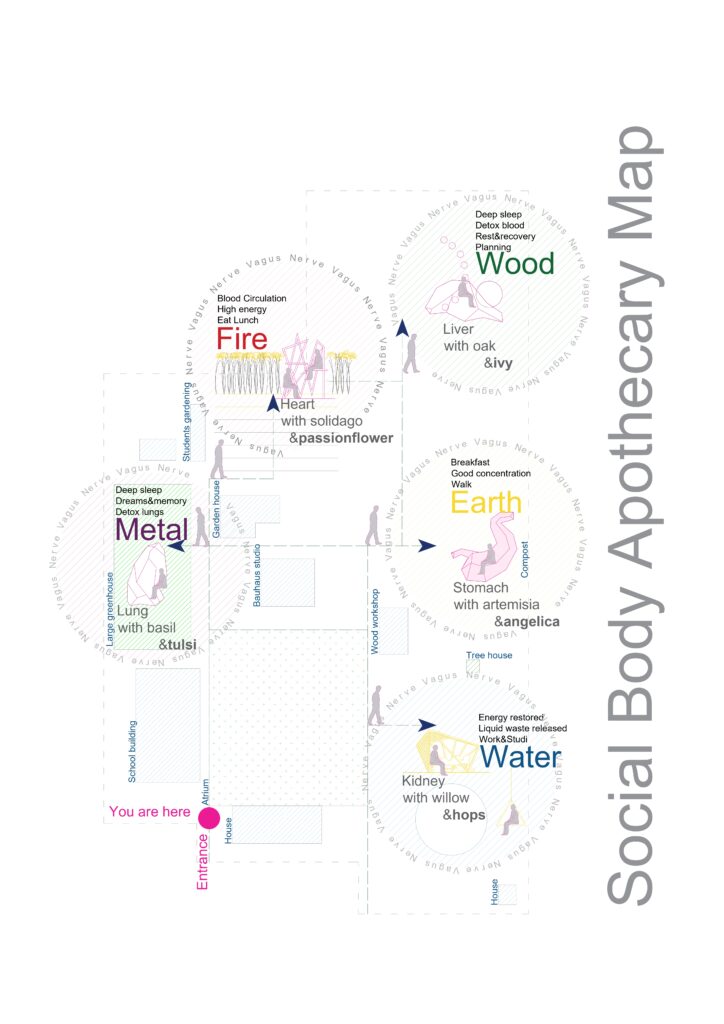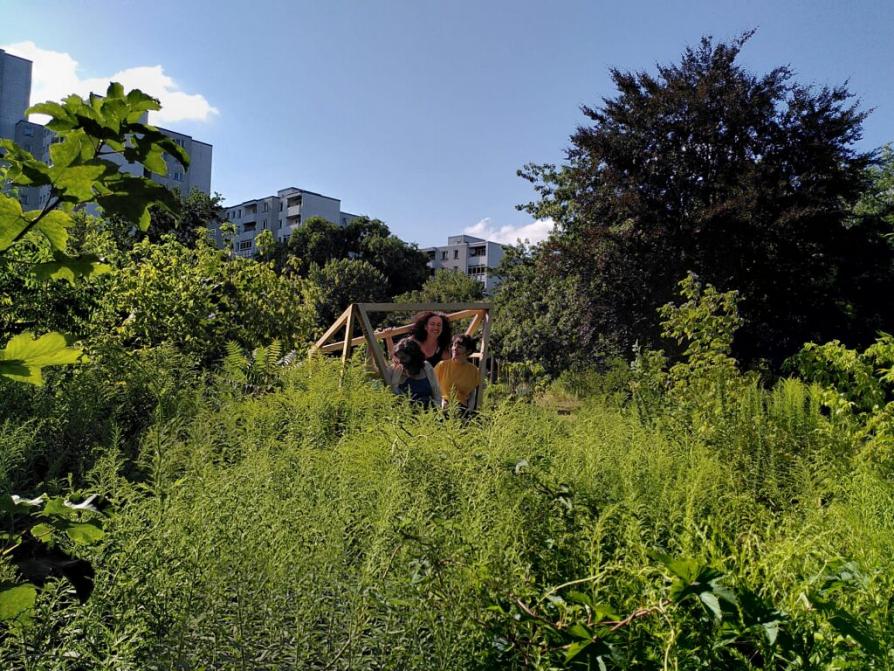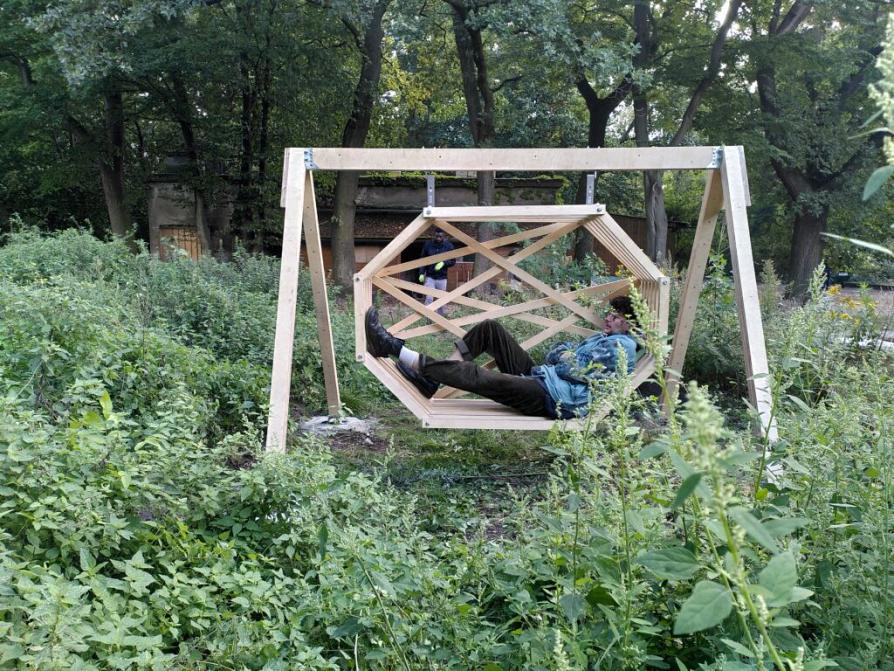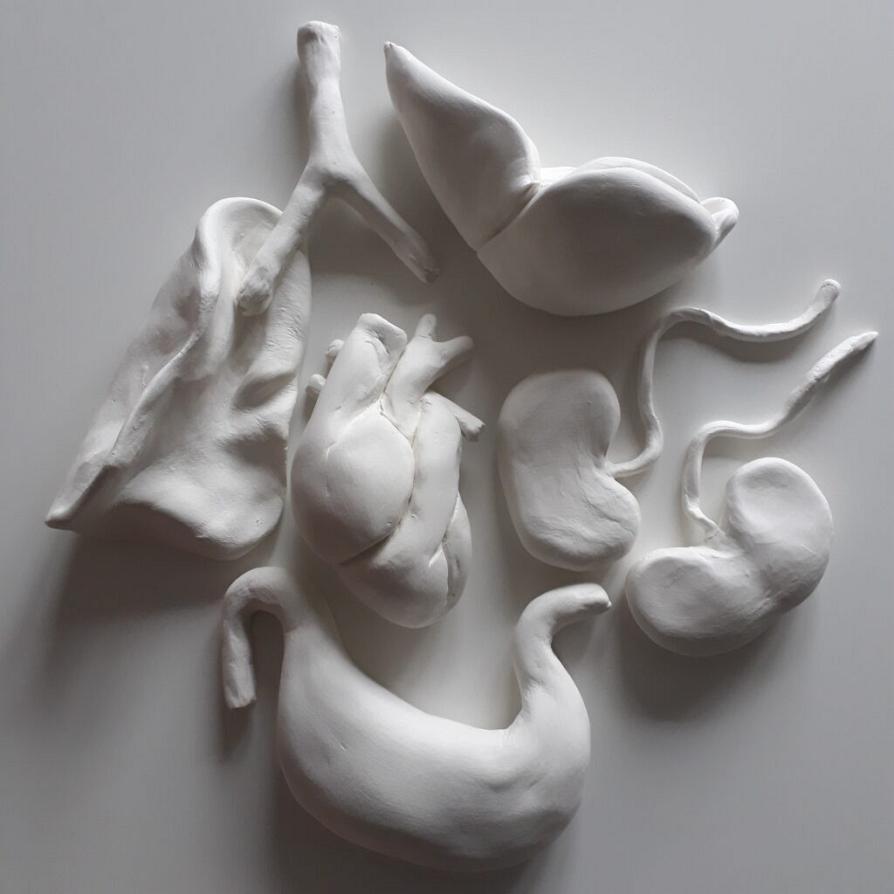The Social-Body Apothecary works with the body as garden and the garden as body. We combine intercultural plant knowledge with bodywork and create space for questions around systemic violence, resilience and regeneration. Through this process, medicinal encounters take place that address the social body. The body that we are proposing is not strictly anatomical. It is mixed, hybrid, queer, monstrous, multiple, relocated, a holistic being that defies norms.

Layering body and garden to study their relations within the socio-ecological context of the Nachbarschaftscampus, we are mapping the entire site through choreographic and cartographic thinking. The process locates particular areas as organ centers which will be partnered with local medicinal plants. Each are configured into a sculptural unit that can be inhabited as spaces for embodied dwelling with the plants and with the qualities of each organ center. The nervous system weaves into and among each of these organ centers, allied with adaptogenic plants. Adaptogens are said to have a regulating effect and support the body’s ability to adapt. The wandering nerve as a mobile herbal clinic serves as a meandering space for collective remedy-making.
The Social Body Apothecary emerges as a physical garden, a social choreography, a community educational platform, and health resourcing space. This transdisciplinary project draws upon knowledges from fields such as Chinese Medicine, Body Mind Centering®️, embryology, herbalism, homeopathy, eco/somatic and embodiment methods, architecture, sculpture, botany and more. The Social Body Apothecary is a space for exchange of embodied practices, creative healing, and interactive learning towards collective health.
Initiators: Kitti Zsika, Shelley Etkin, Siegmar Zacharias
Collaborators: Paule Potulski, Lilja Waehneldt, Jan Stricker, Andries de Lange, Gabriel Nyanakyi, Konstructlab Berlin
Located at the Nachbarschaftscampus / Berlin Mondiale
Funded by: Urbane Praxis, Fonds Darstellender Künste, Neustart Kultur
Personal artistic research towards development of the project supported as a 2020-2021 recipient of the Tanzpraxis Stipend from the Berlin Senate Department of Culture.

Traveling throughout the neighbourhood with collectively created herbal medicines
Each of the organ-dwellings is situated in relation to particular areas of the garden that correspond and plants that ally with its actions. The kidney with its filtering, relating, detoxing, and absorbing actions is situated in the water region, by the ponds and willow tree. The heart who works on connecting, pumping, circulating, orientating is situated in the wild field of goldenrod, where all directions towards the edges of the garden are in view and brought together. The stomach whose work of digesting, metabolising, processing, breaking down, and catalysing align with composting processes. The lungs who enable breathing, releasing, circulating, resonating, and grieving are matched with the moist microclimate of the greenhouses, a transparent otherworld that makes life possible in a unique way. And the liver, with its transmuting, transporting, metabolising, and detoxing actions lives in the underworld forest adjacent to the orchard, among an old oak tree and sea of evergreen ivy. The organ-dwellings are spaces to encounter these processes taking place within us, seemingly invisible but vitally palpable.


The organ-dwellings, and practices for dwelling within our organ environments, invite experience from another perspective. Though the organs seem outwardly invisible and untouchable, we can connect with internal experiences supported by architectural re-imaginings; spending time in these spaces, among the allying plants, offers another possible experience of the internal. Simultaneously, they serve a particular function, offering particular modes of being with/in the garden. The size of the structures invite you to place yourself inside, they invite you into an embodied experience of being within the organ itself. The different seating positions creates different relations by the positionality of your body in the place. Providing a frame, the dwellings offer particular postures to relate with your own body, with the place, and with others.
How can you see from inside? How does your experience of seeing out shift your senses? How might that inform your readings of bodies in place? How can the act of dwelling be resourceful, an anchor point to work with the flow of the whole, rippling into wider social scales, and all the connectivities within those layers?


The apothecary that we are proposing values the knowledges and resources stored in our bodies and lands. Making medicine together is a practice of resistance against structural violence. By building community we can understand the connections between symptoms that appear in individual bodies as indications of what might be rooted in systemic injustices. Through coming together, exchanges and conversations arise that reveal how the experiences we often feel alone with are personal and collective, shared and different. In this process, we come to understand that our experiences are never isolated, but rather exist within a wider context and can meet our bodies in the presence of others as well as the plants of the garden through their medicinal insights, engaging in healing as a collective process.
The ‘apothecary’ originally referred to both a storage space for the medicinal resources and a role in the community, the person who held these knowledges and was available as a resource to distribute them. We propose bringing these back together by acknowledging how these intuitive knowledges are held in the body as a living and intelligent repository. As such, we can reconnect our bodily navigational systems with the living world we are embedded in.




Die Sozialkörper-Apotheke arbeitet mit dem Körper als Garten und dem Garten als Körper und erkundet ihre Beziehungen innerhalb des sozio-ökologischen Kontextes des Nachbarschaftscampus.
Seit Sommer 2021 haben Shelley Etkin, Kitti Acosta-Zsiga und Siegmar Zacharias, in Zusammenarbeit mit dem Campus Dammweg und Mitteln der Urbanen Praxis daran gearbeitet Prozesse und Situationen zu entwickeln, die künstlerische Forschung und Praxis, Arbeit mit Pflanzen und Erde, und sozio-kulturellen Austausch ermöglichen. Die Nachbarn des Nachbarschaftscampus sind vor allem Menschen mit Migrationshintergrund, Migrant*innen und Geflüchtete.
Das Projekt wird aus dem Prozessförderung des Fonds Darstellende Kunst unterstützt, Urbane Praxis, und Neustart Kultur.
Meine künstlerische Recherche zur Entstehung dieses Projektes wurde durch das 2020-2021 Tanzpraxis Stipendium des Berlin Senatsverwaltung für Kultur und Europa gefördert.
